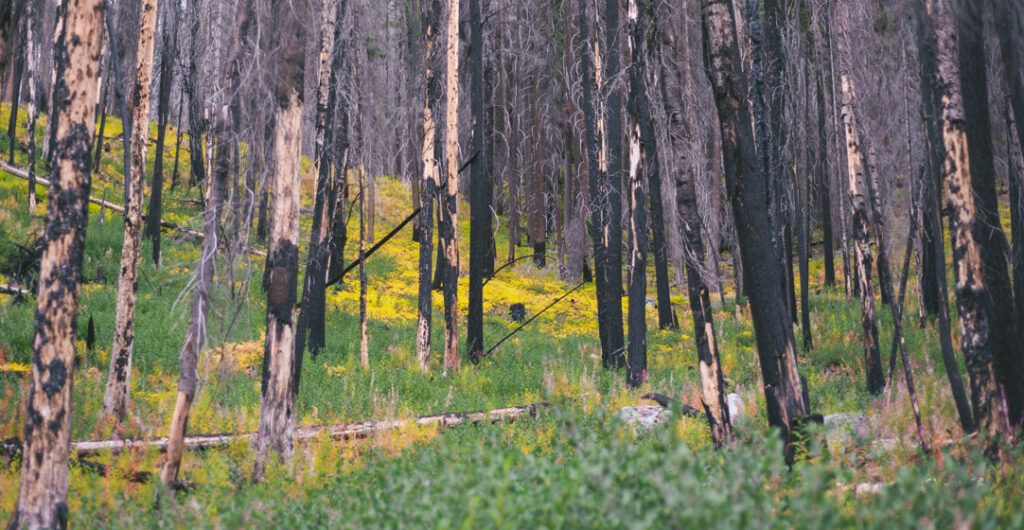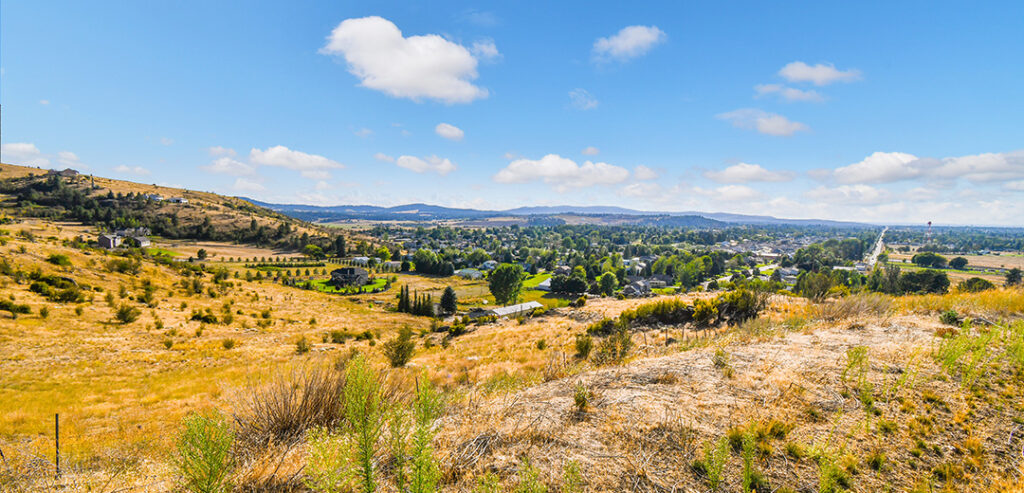Get the right home insurance in Washington and Northern Idaho
It’s no surprise that interest in fire insurance runs high in wildfire-prone areas around Washington state and northern Idaho. Wildfires burn thousands of acres each year in the region.
So, AAA Washington insurance agents get lots of calls from concerned homeowners located in the arid and forested regions of the state.
“Wildfire danger is top of mind in central Washington, especially around Wenatchee and Chelan,” said AAA Washington insurance agent Gary Cantrell, who is based in Kennewick in the Tri-Cities.

Cantrell said if you give him a call to talk about wildfires, he’ll first pinpoint your home on a map and determine your relative risk. Once he knows where your home is located, he can get you a quote for home insurance.
You’ll probably be surprised how easy it is to find insurance to protect your home from wildfire damage.
Does home insurance cover wildfire damage?
The good news for homeowners in Washington and northern Idaho is that wildfire damage is almost always covered under a homeowners’ insurance policy. Except in rare cases when the property is in an extremely remote area, you can find coverage from a private insurer through AAA Washington.
Plus, three AAA Washington insurance carriers — Mutual of Enumclaw, Safeco and Cincinnati — partner with Wildlife Defense System, a private company that works with insurance companies to prevent wildfire damage. Homeowners in higher risk areas that are insured by one of these AAA Washington insurance carriers will automatically qualify for fire prevention services. You can also arrange to have this company visit your home.
“They’ll look at the defensible space around a home,” Cantrell said. “They will prune trees. They will turn sprinklers on and start wetting the area. They’ll go so far as to bring in a foam truck and coat the home with fire-resistant foam.”
Pay special attention to your policy

Provided that you don’t intentionally start the fire, you’ll be covered under the home policy for smoke and fire damage, as well as water damage to the home when firefighters come to put out the fire.
That said, you’ll want to pay special attention to some points about your policy, particularly if you live in an area where wildfires are common. Here are some key considerations:
- Learn your coverage limits or the maximum amount that the policy will pay out to repair or rebuild the home and replace your possessions.
- Read the fine print. Home policies calculate a home’s value in different ways, which can significantly affect how much you’ll receive in a claim if the home is a total loss.
- Review the policy regularly. It is a good idea to review your policy with a AAA Washington agent at least once a year before fire season to ensure that you’re fully covered, particularly if you have recently renovated or added detached structures to the property.
Live in a high-risk area? Consider raising your deductible.

One way to lower the cost of your homeowner’s insurance premium is to raise the damage deductibles, or the amount you’ll agree to pay out of pocket before the insurance company begins paying a damage claim.
You’ll still be protected from the major expense of repairing or rebuilding your home, which would be hard to cover with your savings. But your homeowner’s premium will be lower.
“What we always do is really encourage people to think of their homeowners’ policy as more of a catastrophic loss plan and not use it for the little things,” Cantrell said. “You want to have access to a large bucket of money when you need it most.”
Cantrell noted that if you file small dollar-amount claims on any type of insurance, it will tend to raise your premiums. This is also true of homeowners at a high risk for wildfires.
Why is home replacement value important?
The replacement value of your home is important in case it’s destroyed in a fire. This can be calculated in two ways depending on the policy — and the difference can mean a significantly higher or lower payout if your home needs to be rebuilt after a wildfire.
- Replacement cost coverage will pay out an estimated amount to buy or build a comparable home. This insurance tends to be more common and costs more; however, a replacement-cost policy is recommended because it ensures that you will be able to fully rebuild the home after a fire.
- Actual cash value policies only pay the estimated value of the home at the time of the fire and considers the home’s age and wear-and-tear. These policies will cost less but might not pay out enough to replace/rebuild the home.
How is it calculated?

Insurance companies use analytics tools to estimate your home’s replacement value. These consider your area’s construction costs, the roof type and other materials. The age, shape of the home and square footage, among other factors, will affect its value.
The key point is that the value will change over time, and it is good idea to stay informed about your home’s replacement cost to ensure that you have the right amount of coverage.
What is extended coverage?
Given inflation and building supply chain issues, plus the shortage of skilled workers, home building costs have gone up rapidly in the Pacific Northwest. So, even if you have a replacement cost policy, it’s possible that you won’t have enough money to exactly replicate the home.
For example, the insurance may pay out $300,000 to rebuild the home based on the policy’s coverage limit at the time of the fire, but the actual replacement costs could be $50,000 higher at the time the home is rebuilt. That’s where extended coverage kicks in. The extended coverage will pay a percentage amount above the policy limit.
Tip: Three insurance companies that work with AAA Washington offer guaranteed replacement coverage on homes that are destroyed in fires and other natural disasters. Guaranteed coverage is like extended coverage but has no limit, so the home will be replaced despite the cost.
Do you pay more in certain areas?

If you live in an area at a higher risk for wildfires, you’ll likely pay higher insurance rates, especially if you live in a rural area that’s far away from a fire station.
Insurance companies have historically used a property’s so-called “protection class” to determine its fire risk. Basically, it gauges how fast the insurer thinks a fire truck can get to your house.
The classes go from 1 to 10, with the higher number representing the longest expected emergency response times. Companies also use “FireLine scoring” that accounts for your home’s elevation, road access, etc. The higher your risk for wildfire damage, the higher the premiums.
Can I get insurance in a high-risk area?
In most cases, yes, you can qualify for home insurance from a private insurer regardless of your wildfire risk. AAA Washington agents regularly write new policies for homes and businesses in eastern and central Washington and northern Idaho that are susceptible to wildfires.
In some rare cases, however, a home’s risk is too high, and private insurance isn’t available. Usually, these properties are located in the wilderness and accessible by a single road.
It is possible for homeowners at the highest risk to obtain fire insurance through the Washington FAIR plan, which was established so people could get basic fire coverage for a home or business if they can’t obtain it from a standard insurance company. These policies are more expensive than standard insurance, though, and the program should be considered only after first exploring your private options.
Can I get discounts on home insurance?
Yes, it is possible to get a discount on a home insurance policy by taking steps to lessen the impact of a fire, storm, theft or even water damage to your home. (Water damage can happen at any time of year.) You can typically get a maximum of around 5% off the premium.
Insurance companies, including some AAA Washington carriers, give discounts for the following improvements:
- Installing water shut-off devices that detect when a pipe has burst or is leaking;
- Adding home security to prevent theft.
Can I reduce the risk of wildfire damage?

The U.S. Fire Administration also recommends some steps to minimize the risk of a wildfire. These include:
- Avoid storing firewood under or near the house that can become fuel for a fire;
- Trim tree branches that hang over the eaves or roof;
- Remove mulch, leaves and pine needles around at least a 5-foot perimeter of the house;
- Keep the area around the house well-watered and green;
- Prune and remove dead or dying branches from the trees within a 30-foot perimeter;
- Stack wood piles at least 30 feet away from the house;
- Thin out and space trees and vegetation within a 100-foot perimeter of the home.
Are condos covered for wildfire damage?
Yes, condo insurance policies will also cover damage from wildfires. However, the insurance works differently than for a detached house and can get complicated. A condo will be covered for fires by two levels of insurance:
- A master policy, obtained by the condominium association, covers the building’s exterior, the roof, common areas, fences and property, etc.
- An individual policy, obtained by each condo owner, covers damage within the condo, including to your possessions, furniture and often damage to the fixtures.
One thing to note about condo insurance is that master policies vary significantly in what they’ll cover. Sometimes the individual condo owner is responsible for rebuilding from the metal studs out. In other cases, the condo’s master policy will pay to finish the walls and replace fixtures and appliances.
So, you should find out what the condo’s master policy will cover before buying the condo and purchasing your individual insurance. Other nuances are in play when insuring a condo. Read more about condo insurance here.
6 steps to take after a fire
Unfortunately, fires destroy homes every year. If you are unlucky enough to experience any type of fire at your home and need to file an insurance claim, take these six steps:
- Contact your insurance agent and update them on the situation.
- Take photographs of any damage.
- Itemize all damaged property.
- Move any property that is salvageable to a protected area.
- Secure the building with boards at all entry points.
- Keep receipts of any expenses associated with the cleanup or fire.
While the threat of wildfires comes around every summer, the good news for homeowners in higher risk areas is that insurance is available. Contact a AAA Washington agent today to discuss your options.
—Written by AAA Washington staff
—Top photo: AdobeStock

